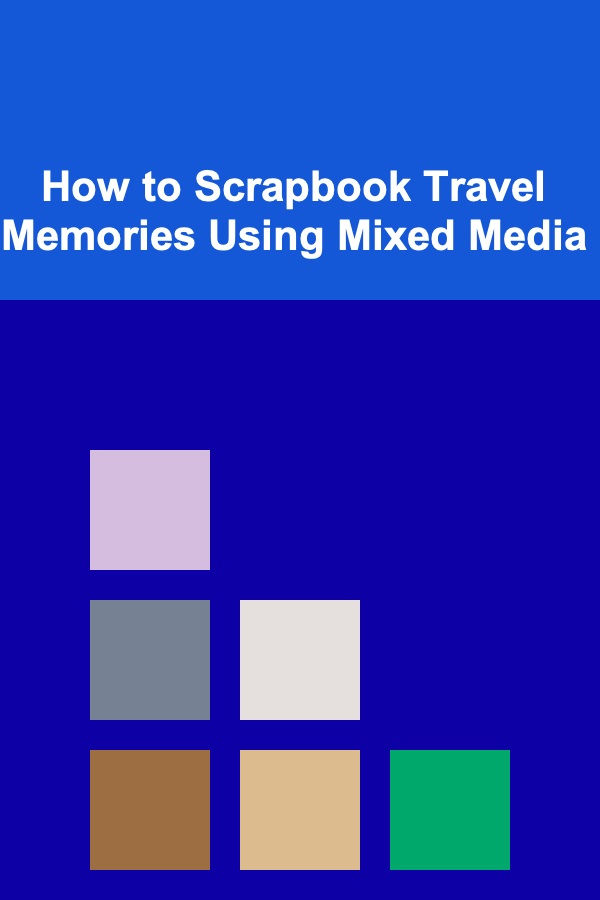
How to Scrapbook Travel Memories Using Mixed Media
ebook include PDF & Audio bundle (Micro Guide)
$12.99$10.99
Limited Time Offer! Order within the next:

Scrapbooking is more than just a hobby; it's a way of preserving the essence of your travels and the emotions tied to those unforgettable experiences. Whether you're embarking on a grand adventure or taking a weekend trip, scrapbooking allows you to reflect on and share the unique stories of your travels. When you introduce mixed media into the process, your scrapbook pages come to life with vibrant textures, colors, and materials, enhancing the memories you wish to capture.
This comprehensive guide will take you through the process of creating a travel scrapbook using mixed media techniques. From the basics of mixed media to step-by-step instructions for crafting stunning travel memory pages, you'll discover how to transform your photos, souvenirs, and mementos into tangible works of art.
Understanding Mixed Media in Scrapbooking
What Is Mixed Media?
Mixed media refers to the combination of different artistic mediums and materials in one piece. When applied to scrapbooking, it involves incorporating not just paper and photos, but also elements such as fabric, paints, inks, stamps, embossing powders, stencils, metal embellishments, and more. The beauty of mixed media scrapbooking is that it allows for limitless creativity. There are no rules---just layers of materials and textures that tell the story of your journey.
Why Use Mixed Media for Travel Scrapbooking?
Travel memories are rich with experiences---places, people, emotions, and fleeting moments. Using mixed media can add depth and a personal touch to your scrapbook that traditional methods cannot always achieve. Mixed media scrapbooking lets you experiment with texture and dimension, giving your travel pages a dynamic look and feel. It also gives you more freedom to incorporate memorabilia, such as tickets, postcards, maps, and other souvenirs that symbolize your adventure.
The Essential Tools and Materials for Mixed Media Scrapbooking
Before diving into your travel scrapbook project, you'll need to gather the right materials. The combination of tools and supplies depends on the effects you're trying to create, but here are some of the basic materials you'll want on hand:
1. Paper and Cardstock
- Patterned Paper: Choose travel-themed or neutral patterned paper that complements your photos.
- Plain Cardstock: A sturdy background for your photos, journaling, or mixed media layers.
- Textured Paper: Adds depth and interest to your layouts.
2. Inks and Paints
- Distress Inks: Perfect for adding a vintage or aged look to your pages.
- Acrylic Paints: Versatile for creating backgrounds, splatters, or texture.
- Watercolors: Ideal for a soft, fluid look that can be layered with other elements.
- Ink Pads: Use for stamping and adding fine details.
- Spray Mists: Adds color and texture in the form of splatters or even large washes.
3. Stamps and Stencils
- Rubber Stamps: Used to create borders, accents, or text on your pages.
- Stencils: Ideal for applying consistent shapes or patterns with ink or paint.
- Embossing Stamps: Create raised textures on your pages, adding a tactile element.
4. Embellishments
- Washi Tape: A versatile, colorful tape that can be used for borders, layering, or accents.
- Buttons, Brads, and Charms: Small embellishments to add dimension and character to your layouts.
- Ribbons and Fibers: Texture-rich materials to weave through your pages for added visual interest.
- Die-Cuts: Pre-cut shapes, letters, or images that can be layered onto your page.
5. Adhesives
- Glue Sticks: For adhering paper and lighter elements.
- Double-Sided Tape: Ideal for sticking down photos and embellishments.
- Foam Adhesive Dots: Add height and dimension to your elements.
- Mod Podge: Perfect for sealing and protecting your layers, as well as for creating texture.
6. Memorabilia
- Photographs: Your travel memories in picture form.
- Maps: Use pieces of maps to highlight locations or routes.
- Tickets, Brochures, and Postcards: These small items hold great sentimental value and can be incorporated directly into your pages.
7. Other Miscellaneous Materials
- Journaling Pens: For writing down your thoughts, dates, locations, and stories.
- Gesso: A base for your mixed media art, providing texture and surface preparation.
- Modeling Paste: Adds even more texture and can be stenciled onto your page for a 3D effect.
Techniques for Scrapbooking Travel Memories Using Mixed Media
1. Create Textured Backgrounds
Mixed media allows you to make the background of your scrapbook pages more than just a flat surface. Begin by applying a layer of gesso to your cardstock or paper to create a textured base. Once the gesso dries, you can use acrylic paints, watercolors, or spray mists to create dynamic backgrounds.
- Technique Tip: Use a stencil and modeling paste for raised textures on the background. The paste will dry into a 3D effect that adds depth to your page.
2. Incorporate Photos with Layers
While photos are the focal point of most scrapbooking pages, mixed media allows you to make them stand out even more. Layer your photos on top of painted or inked areas, or create collages of photos with other travel memorabilia.
- Technique Tip: Frame your photos with washi tape, die-cut shapes, or paper scraps to add dimension. You can even distress the edges of your photos for an old-world or vintage feel.
3. Use Stamping and Embossing
Stamping is an easy way to add unique designs and accents to your pages. For travel scrapbooking, look for stamps that represent the places you've visited or things you've experienced. For example, stamps with maps, globes, landmarks, or transportation symbols can be perfect.
- Technique Tip: Combine stamping with embossing powders. After stamping with ink, apply embossing powder and heat it to create a raised, shiny effect. This technique works well with travel-themed stamps like "Adventure," "Explore," or "Journey."
4. Incorporate Mixed Media Memorabilia
One of the highlights of scrapbooking is the ability to include physical memorabilia from your travels. Incorporate train tickets, hotel receipts, brochures, and postcards into your pages.
- Technique Tip: Use Mod Podge or a similar adhesive to glue items to your page. For a more vintage look, ink the edges of these pieces with a distressed ink pad. Also, layering these items over a painted or stamped background can create a striking contrast.
5. Use Texture Paste for 3D Effects
Texture paste is a mixed media material that adds an incredible tactile element to your scrapbook. Whether you're creating raised patterns with stencils or building up areas to resemble terrain or textures from your travels, paste can bring your pages to life.
- Technique Tip: Apply the paste with a palette knife and allow it to dry before coloring with inks or paints. You can also mix in some glitter or metallic powder for added flair.
6. Add Journaling and Quotes
Adding personal reflections or quotes from your travels can bring a deeper meaning to your scrapbook. Handwritten journaling is a lovely way to express your emotions about a particular moment or place, but you can also use printed text or stamps.
- Technique Tip: Use a mix of hand lettering and printed text for visual variety. Try stamping a quote or using a die-cut alphabet for your journaling.
7. Layer, Layer, Layer
The beauty of mixed media scrapbooking lies in its layered look. Don't be afraid to add multiple layers to your pages using paper, fabric, photos, embellishments, and textures.
- Technique Tip: Create clusters of embellishments or photos and layer them over painted or inked backgrounds. Use foam adhesive to add dimension between layers for an even more dramatic effect.
8. Create Interactive Elements
For a more dynamic scrapbook, include interactive elements such as pull-out tabs, hidden pockets, or flip-book pages. These features invite your viewers to explore your travel memories more intimately.
- Technique Tip: Use a small envelope to store tickets or notes from a specific place and attach it to your page with brads or string. Make sure it blends seamlessly with the overall design of your page.
9. Incorporate Maps and Symbols
Maps are an incredible addition to travel scrapbooks. Whether you're using them as background material, cutting out specific locations, or adding stamps for locations visited, maps bring a geographic element to your storytelling.
- Technique Tip: Use a map as a background and layer photos or text over it. If you've collected several maps from different cities or countries, cut them into the shapes of regions you've visited and create a collage-style page.
10. Experiment with Color
Don't be afraid to experiment with bold colors, especially those that capture the mood of your travels. If you're scrapbooking a beach vacation, consider using ocean blues, sandy yellows, and sun-kissed oranges. For a trip through the mountains, go for earthy tones and greens.
- Technique Tip: Use color blocking or watercolors to create contrast and interest across your page. Don't hesitate to add splashes or drips of paint to create a spontaneous, free-flowing look.
Final Thoughts: Making Your Travel Memories Last
Scrapbooking with mixed media allows you to take your travel memories to the next level. Through the use of creative techniques, textures, and layers, you can bring to life the places you've been, the people you've met, and the emotions you've felt along the way. The beauty of mixed media is that it gives you the freedom to play, explore, and experiment with endless combinations of materials.
As you embark on your travel scrapbook journey, remember that there are no strict rules---just your own personal style and creative vision. Each page you create will be a reflection of your unique adventure. By adding mixed media to your pages, you're not just preserving memories; you're also telling a vivid, tactile, and unforgettable story. Happy scrapbooking!
Reading More From Our Other Websites
- [Home Cleaning 101] How to Tackle Common Cleaning Mistakes and Avoid Damage
- [Home Maintenance 101] How to Make Energy-Efficient Home Upgrades and Save on Bills
- [Home Space Saving 101] How to Save Space in Your Bedroom with Smart Furniture Choices
- [Organization Tip 101] How to Declutter Your Home in 30 Days
- [Personal Finance Management 101] How to Teach Kids About Money Management
- [Personal Care Tips 101] How to Apply Sunscreen for Maximum Effectiveness in the Sun
- [Personal Care Tips 101] How to Use Facial Cleanser to Help Prevent Breakouts
- [Organization Tip 101] How to Use Carts for Mobile Laundry Storage
- [Stamp Making Tip 101] Troubleshooting Common Rubber Stamp Issues: Ink Bleed, Durability, and Clean-Up Hacks
- [Organization Tip 101] How to Maintain Your Walk-in Shower for Long-lasting Beauty and Functionality

How to Declutter Your Closet Using the Four-Box Method
Read More
How to Establish a Daily Routine for Pet Care
Read More
How to Incorporate Smart Lighting into Your Home
Read More
Leading the Charge: Effective Leadership and Management Skills for Nurse Practitioners in Today's Healthcare Environment
Read More
How To Stay Safe as a Solo Digital Nomad
Read More
How to Create a Productivity Toolkit
Read MoreOther Products

How to Declutter Your Closet Using the Four-Box Method
Read More
How to Establish a Daily Routine for Pet Care
Read More
How to Incorporate Smart Lighting into Your Home
Read More
Leading the Charge: Effective Leadership and Management Skills for Nurse Practitioners in Today's Healthcare Environment
Read More
How To Stay Safe as a Solo Digital Nomad
Read More